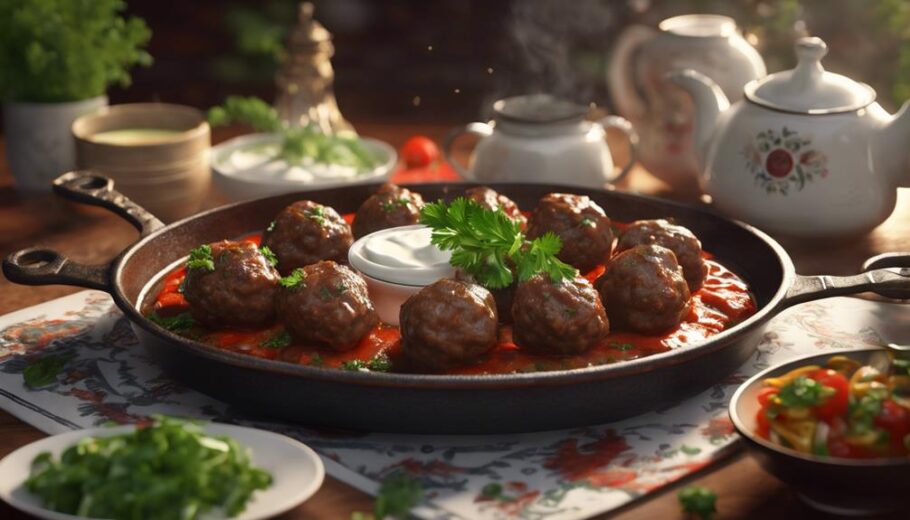Prepare to be captivated by the tantalizing blend of spices and tender textures that set Turkish kofte apart from ordinary meatballs.
 Add to Recipe Book
Add to Recipe BookYou’ve likely savored many types of meatballs, but have you experienced the distinct qualities of Turkish kofte? From the tantalizing blend of spices to the tender textures that melt in your mouth, Turkish meatballs offer a culinary journey that goes beyond mere flavor. The secret ingredients and cooking techniques employed create a sensory experience that lingers on your palate, leaving you curious to explore further into the world of these delectable meaty delights.
Flavorful Blend of Spices
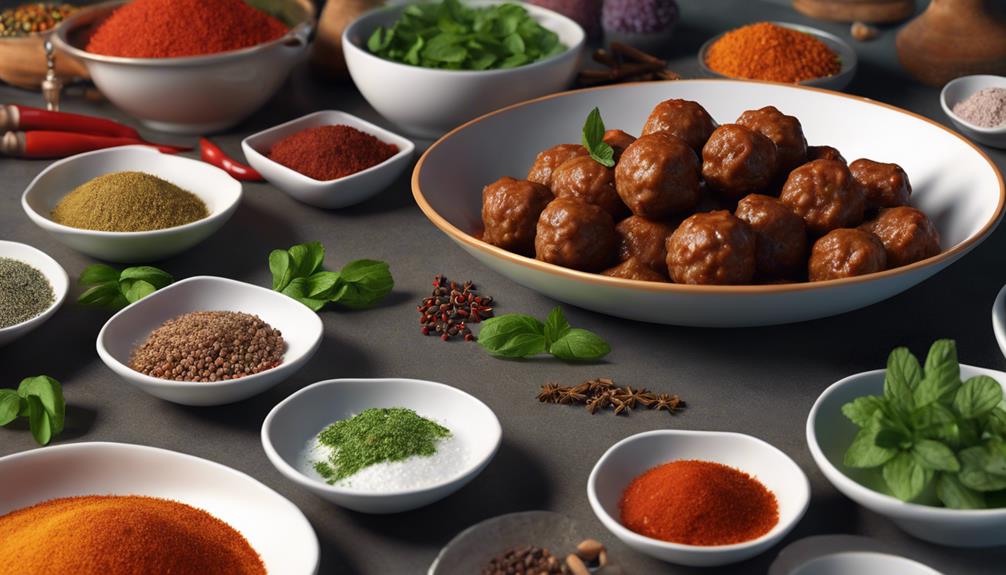
Experience the burst of flavors from the unique blend of spices used in Turkish meatballs. The spice blends in Turkish meatballs are a pivotal element that gives them their international appeal. These meatballs aren’t only a popular dish in Turkey but have also gained recognition worldwide for their exquisite taste and aromatic profile.
The cooking techniques used to prepare Turkish meatballs are key to achieving their distinct flavor. By blending spices like cumin, paprika, and sumac, the meat becomes infused with a rich and complex taste that sets Turkish meatballs apart from others. This fusion cuisine approach combines traditional Turkish flavors with a modern twist, creating a dish that appeals to a wide range of palates.
The spice blends used in Turkish meatballs are carefully selected to enhance the overall dining experience. Each bite offers a symphony of flavors that dance on your taste buds, leaving you craving more. The balance of spices creates a harmonious blend that elevates the meatballs to a culinary masterpiece.
Whether you enjoy them on their own, with a side of rice, or in a sandwich, Turkish meatballs never fail to impress with their tantalizing blend of spices. This culinary delight is a tribute to the artistry of Turkish cuisine and its ability to captivate food lovers around the globe.
Tender and Juicy Texture
Indulge in the succulent tenderness and juicy perfection of Turkish meatballs, a hallmark of their culinary excellence. Turkish meatballs, known as ‘köfte’, are renowned for their melt-in-your-mouth texture that keeps you coming back for more. Achieving the ideal tenderness and juiciness in Turkish meatballs requires a few key cooking tips to secure a delightful dining experience.
When preparing Turkish meatballs, a perfect pairing is using a combination of ground beef and ground lamb. The blend of these meats contributes to the tenderness and juiciness of the meatballs. Additionally, incorporating grated onion into the meat mixture helps retain moisture, enhancing the succulence of each bite.
To further elevate the texture of Turkish meatballs, avoid overmixing the meat mixture. Gently combine the ingredients until just incorporated to prevent a dense texture. Another cooking tip is to refrigerate the shaped meatballs for about 30 minutes before cooking. This step helps the meatballs hold their shape and retain their juices during the cooking process.
Below is a table summarizing the key points for achieving the perfect tenderness and juiciness in Turkish meatballs:
| Key Points |
|---|
| Blend of meats |
| Grated onion |
| Avoid overmixing |
| Chill meatballs |
| Perfect Pairing |
Fresh Herbs in the Mix
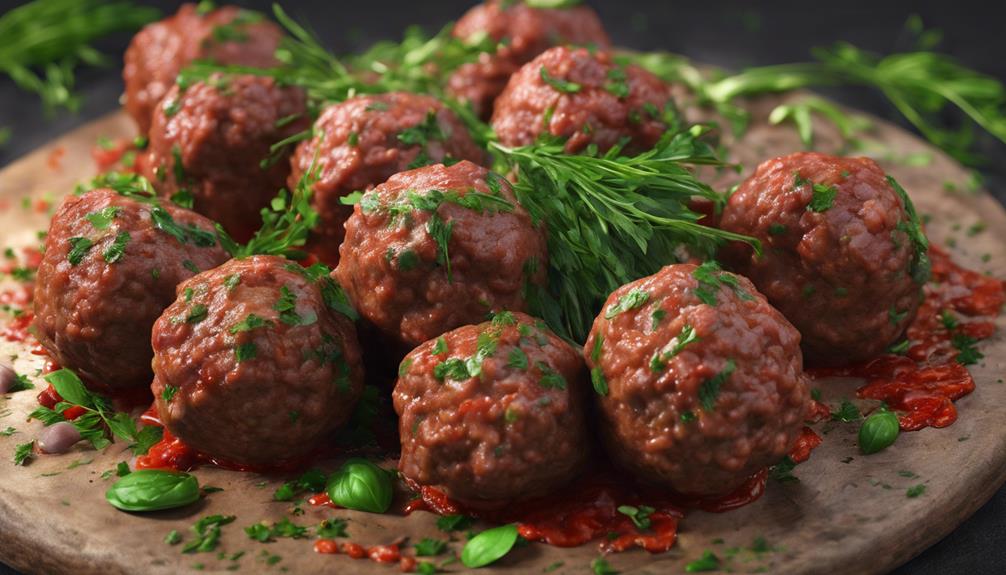
Improve the flavor profile of Turkish meatballs by integrating a variety of fresh herbs into the meat mixture. By infusing your meatballs with a range of fresh herbs, you can elevate the taste to a whole new standard. The herb-infused flavors not only add depth but also demonstrate your culinary creativity in the kitchen.
Using fresh ingredients like parsley, mint, dill, or oregano provides an aromatic sensation that distinguishes Turkish meatballs. These herbs bring a burst of freshness and vibrancy to each bite, creating a harmonious fusion of flavors that tantalize your taste buds. The vivid colors of the herbs also enhance the visual appeal of the dish, making it even more enticing.
When incorporating the herbs into the meat, chop them finely to guarantee that every bite contains a well-balanced distribution of flavors. The herbs not only enrich the taste but also contribute to the overall texture of the meatballs. This meticulous approach to integrating fresh herbs demonstrates a commitment to excellence and a love for crafting unforgettable dining experiences.
Next time you prepare Turkish meatballs, consider experimenting with various herb combinations to uncover your unique flavor profile. Let the inherent essence of fresh herbs elevate your meatballs into a culinary masterpiece that will impress even the most discerning palates.
Versatile Cooking Methods
Diversify your culinary skills by exploring various methods to cook Turkish meatballs, enhancing your versatility in the kitchen. Turkish meatballs, also known as ‘köfte,’ offer a range of cooking techniques that can elevate the flavors and textures of this beloved dish.
Grilling techniques are a popular way to cook Turkish meatballs, imparting a smoky flavor while creating a crispy exterior. Whether on a traditional charcoal grill or a gas grill, the high heat helps seal in the juices, resulting in juicy and flavorful meatballs.
Oven-baked variations offer a convenient method for cooking Turkish meatballs. By baking them in the oven, you can achieve a consistent cooking temperature, ensuring that the meatballs are cooked through evenly. This method is great for larger batches or when you want a hands-off approach to cooking.
For those seeking a more tender and flavorful result, slow cooking Turkish meatballs is a fantastic option. By simmering the meatballs in a flavorful sauce for an extended period, the meat becomes incredibly tender, soaking up all the delicious flavors.
Pan-searing methods provide a quick and easy way to cook Turkish meatballs while achieving a crispy exterior. By searing the meatballs in a hot pan, you can develop a caramelized crust, adding a depth of flavor to the dish.
Experimenting with these versatile cooking methods will allow you to enjoy Turkish meatballs in various delicious ways.
Cultural Significance in Turkey

You should know that Turkish meatball traditions are deeply rooted in the country’s culture, symbolizing hospitality and togetherness.
Meatball festivals in Turkey bring communities together to celebrate this beloved dish, showcasing different variations and cooking techniques passed down through generations.
These cultural events not only highlight the culinary importance of meatballs but also serve as a way to honor tradition and heritage in Turkish society.
Turkish Meatball Traditions
Turkish meatball traditions hold deep cultural significance in Turkey, reflecting the country’s rich culinary heritage and communal dining customs. These traditions are rooted in history and are an integral part of Turkish cuisine.
When it comes to Turkish meatballs, there are three key aspects that highlight their importance in Turkish culture:
- Meatball History: Turkish meatballs, known as ‘köfte,’ have a long and storied history dating back centuries. They were initially created as a way to preserve meat by mixing it with various spices and grains, making them a versatile and long-lasting food option.
- Meatball Cooking Techniques: The art of making Turkish meatballs involves various cooking techniques, such as grilling, frying, or baking. Each method imparts a unique flavor and texture to the meatballs, showcasing the diverse culinary skills of Turkish chefs.
- Communal Dining Customs: In Turkey, enjoying meatballs isn’t just about the food itself but also about the communal experience. Families and friends often gather around a table to share a meal of köfte, fostering bonds and creating lasting memories through the act of dining together.
Meatball Festivals in Turkey
Meatball festivals in Turkey bring communities together to celebrate the culinary artistry and cultural significance of this beloved dish. These festivals often feature meatball competitions where local chefs and home cooks showcase their skills in creating the most flavorful and perfectly grilled meatballs. The friendly rivalry in these competitions adds excitement to the festivities, with participants vying for the title of the best meatball maker in the region.
Moreover, meatball festivals in Turkey have become a highlight for culinary tourism, attracting food enthusiasts from around the world. Tourists flock to these events to not only indulge in the delicious meatball varieties but also to immerse themselves in the vibrant atmosphere filled with music, dance, and traditional Turkish hospitality.
Attending a meatball festival in Turkey isn’t just about savoring the dish but also about experiencing the rich cultural heritage and sense of community that revolves around this iconic food. It’s a celebration that appeals to both locals and visitors alike, making it a must-see event for anyone interested in exploring Turkey’s culinary traditions.
Unique Ingredient Combinations
Uniquely blending spices like cumin and sumac with ground meat sets Turkish meatballs apart from other variations worldwide. This fusion of flavors creates an invigorating taste experience that’s both familiar and unexpected. Turkish meatballs, or ‘köfte,’ are known for their unique ingredient combinations that elevate them to a whole new level of culinary delight.
Here are three unexpected ingredient pairings that contribute to the distinctive taste of Turkish meatballs:
- Pomegranate Molasses and Pine Nuts: The combination of sweet and tangy pomegranate molasses with crunchy pine nuts adds a burst of flavor and texture to traditional Turkish meatballs. This creative twist enhances the overall taste profile, making each bite a delightful surprise.
- Mint and Aleppo Pepper: The use of fresh mint leaves and Aleppo pepper in Turkish meatballs infuses them with an invigorating herbaceous aroma and a subtle heat that lingers on the palate. This fusion of flavors creates a harmonious balance that’s both satisfying and intriguing.
- Apricots and Pistachios: Adding diced apricots and crushed pistachios to the meatball mixture imparts a subtle sweetness and nuttiness that complements the savory elements perfectly. These unexpected additions provide a burst of flavor and a delightful crunch in every bite, making Turkish meatballs a true culinary masterpiece.
Regional Variations in Recipes
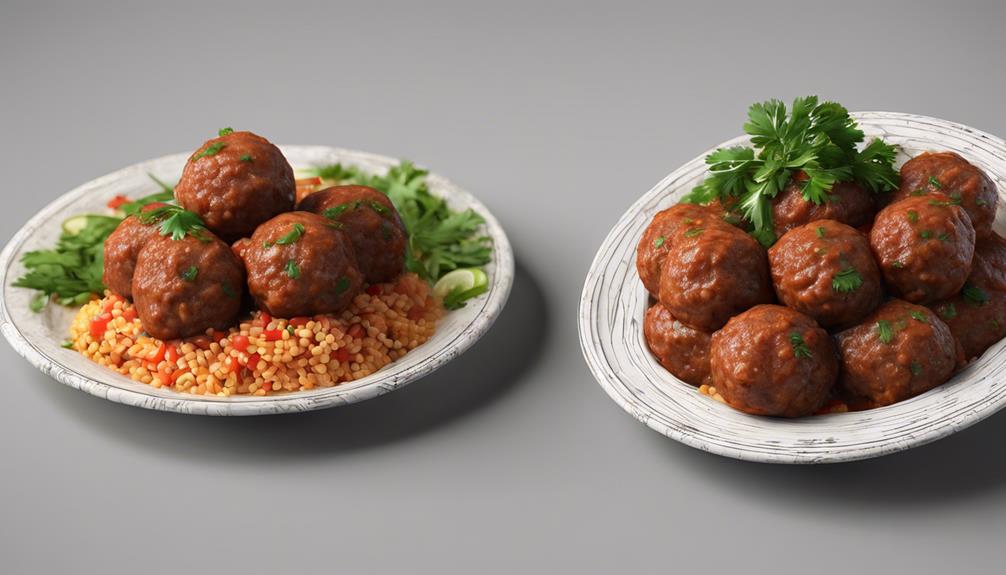
Across different regions in Turkey, various culinary traditions influence the recipes and preparation methods of meatballs, resulting in unique regional variations. Ingredient variations play a significant role in these regional differences. For instance, in the Black Sea region, meatballs are often made with cornmeal, which gives them a distinct texture and flavor compared to meatballs from other areas.
In contrast, in the southeastern region of Turkey, bulgur is a common ingredient used in meatball recipes, adding a nutty taste and a slightly chewy texture.
Cooking techniques also vary among regions, contributing to the diversity of Turkish meatball styles. In the Aegean region, meatballs are typically grilled over an open flame, giving them a smoky flavor and crispy exterior. On the other hand, in the Central Anatolia region, meatballs are often slow-cooked in a rich tomato sauce, resulting in tender and juicy meatballs with a flavorful sauce.
Regional meatball styles are also influenced by historical factors. For example, in the Marmara region, where the Ottoman Empire once thrived, meatballs are often made with a blend of spices such as cumin, allspice, and paprika, reflecting the multicultural influences of the empire. These historical influences continue to shape the unique characteristics of Turkish meatballs across different regions.
Traditional Serving Accompaniments
When enjoying Turkish meatballs, you’ll find that classic side dishes play an essential role in enhancing the overall dining experience. From traditional accompaniments like bulgur pilaf and cacik to modern flavor twists like grilled vegetables and fresh salads, the variety of options allows you to customize your meal to suit your taste preferences perfectly.
These complementary dishes not only add depth to the flavors but also showcase the versatility and adaptability of Turkish cuisine.
Classic Side Dishes
Consider serving Turkish meatballs with a classic side dish like bulgur pilaf, a popular choice that complements the flavors of the meatballs perfectly.
Here are three classic pairings that bring out the traditional flavors of Turkish meatballs:
- Cacik (Tzatziki): This invigorating yogurt-based side dish with cucumber and garlic adds a cool contrast to the warm and savory meatballs. The tanginess of the cacik balances the richness of the meat, creating a delightful combination that has been enjoyed for generations.
- Shepherd’s Salad: A light and colorful salad made with diced cucumbers, tomatoes, onions, and parsley dressed in a simple olive oil and lemon juice vinaigrette. The crispness of the salad enhances the hearty flavors of the meatballs, offering a well-rounded meal experience.
- Turkish Grilled Vegetables: A medley of zucchini, eggplant, bell peppers, and onions grilled to perfection. These smoky and charred vegetables provide a modern twist on traditional side dishes, showcasing international influences while complementing the robust taste of Turkish meatballs.
Modern Flavor Twists
To add a contemporary touch to your traditional Turkish meatball meal, consider incorporating modern flavor twists into the classic serving accompaniments. Embracing fusion cuisine and creative twists can elevate the dining experience and introduce innovative recipes with global influences to your table.
One way to modernize your Turkish meatball meal is by serving them with a side of avocado tzatziki. This unique twist combines the creamy richness of avocado with the invigorating flavors of traditional tzatziki, adding a delightful fusion element to the dish.
Another idea is to pair your meatballs with a Moroccan-inspired couscous salad, featuring dried fruits, nuts, and aromatic spices. This innovative recipe brings together the best of Turkish and North African cuisines, creating a harmonious blend of flavors and textures.
Health Benefits of Turkish Meatballs
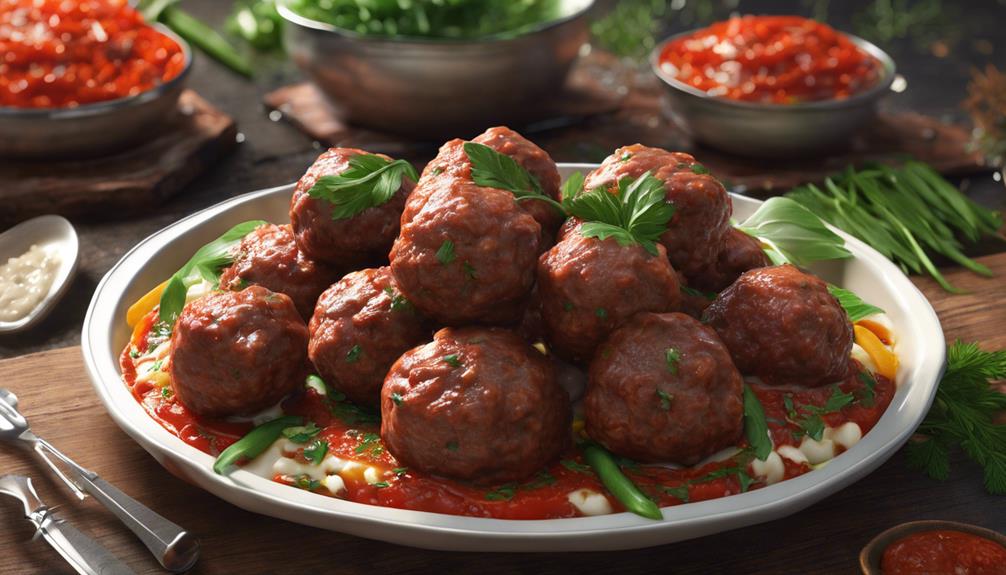
You can enjoy not just the flavor but also the health benefits of Turkish meatballs due to their lean meat and rich blend of spices. Here are three reasons why Turkish meatballs are a nutritious choice:
- Protein Benefits: Turkish meatballs are an excellent source of protein, which is vital for building and repairing tissues in your body. The lean meat used in Turkish meatballs provides high-quality protein without excessive amounts of unhealthy fats, making it a healthier option compared to other meat dishes. Protein also helps you feel full for longer periods, aiding in weight management and muscle development.
- Nutritional Value: Turkish meatballs are typically made with a variety of herbs and spices like parsley, garlic, and cumin, which not only enhance the taste but also add to the nutritional value. These ingredients are rich in antioxidants, vitamins, and minerals that support overall health. Additionally, the use of whole ingredients in Turkish meatballs ensures that you’re consuming a meal that’s wholesome and nourishing.
- Cooking Techniques and Recipe Variations: Turkish meatballs can be prepared using various cooking techniques such as grilling, baking, or pan-frying. Each method offers a unique flavor profile and texture to the meatballs. Additionally, there are recipe variations that incorporate different ingredients like yogurt or mint, allowing you to customize the dish to suit your preferences while still gaining the health benefits.
Popular Street Food Option
One of the most sought-after street food options in Turkey is the flavorful and convenient Turkish meatballs, known as ‘köfte‘. These delicious meatballs are a popular choice for locals and tourists alike due to their savory taste and quick, on-the-go nature. When enjoying köfte as a street food option, it’s vital to be mindful of street food etiquette. Enjoy your meal while walking, but be sure to dispose of any waste properly to keep the streets clean.
Turkish meatballs aren’t just any ordinary street food; they often come with a touch of tradition and secret recipes passed down through generations. The secret recipes used by different vendors give each köfte a unique flavor profile that sets them apart. As you stroll through the bustling streets of Turkey, you’ll encounter various köfte stalls, each boasting their special blend of spices and cooking techniques. Don’t hesitate to try different vendors to experience the diverse range of flavors Turkish meatballs have to offer.
Part of the joy of sampling köfte as a popular street food option is uncovering these hidden gems with secret recipes. While some vendors may share a glimpse into their cooking methods, others guard their recipes closely, adding an air of mystery and intrigue to the experience. Embrace the adventure of trying new köfte varieties and savoring the delicious results of these well-kept culinary secrets.
Frequently Asked Questions
Are Turkish Meatballs Typically Spicy?
Turkish meatballs can spark a spicy debate among food enthusiasts. In Turkish culture, there’s a mix of flavors used, but not all meatballs are typically spicy.
This variation in spiciness is influenced by regional preferences and individual recipes. While some Turkish meatballs may have a bit of heat, others focus more on the savory and aromatic aspects of the dish.
It all boils down to personal taste and cultural traditions.
How Do Turkish Meatballs Differ From Other Cuisines?
When comparing Turkish meatballs to other cuisines, you’ll notice unique cooking techniques and cultural influences that set them apart.
Ingredient variations and regional differences play a significant role in defining Turkish meatballs. These factors contribute to the distinct flavors and textures that make Turkish meatballs stand out in the culinary world.
Whether it’s the blend of spices or the preparation methods, Turkish meatballs offer a one-of-a-kind dining experience that showcases the rich diversity of Turkish cuisine.
Can Turkish Meatballs Be Made With Different Meats?
Yes, you can make Turkish meatballs with various meats. Meatball variations in Turkish cuisine include beef, lamb, or a mix of both. Traditional recipes often feature a blend of spices and herbs unique to Turkish culture.
Cultural preferences may lean towards certain meats over others. Cooking techniques like grilling or pan-frying are commonly used to prepare these delicious meatballs. Experiment with different meats to discover your favorite Turkish meatball recipe.
Are There Specific Rules for Shaping Turkish Meatballs?
When shaping Turkish meatballs, remember the traditional techniques hold cultural significance. Hand-rolling into small, round shapes is common, but don’t be afraid to experiment with different forms.
The key is to guarantee they cook evenly. Some families have their unique shaping methods passed down through generations.
Enjoy the process and don’t hesitate to add your personal touch while respecting the heritage behind these delicious meatballs.
Are There Any Superstitions or Beliefs Associated With Turkish Meatballs?
Superstitions and beliefs about Turkish meatballs vary, with some traditions suggesting that the shape of the meatballs can bring luck or ward off evil spirits.
As you shape the meatballs, consider these superstitions and embrace the cultural significance behind them.
Conclusion
Indulge in the diverse and vibrant flavors of Turkish meatballs, where every bite is a culinary adventure.
With a blend of unique spices, tender textures, and fresh herbs, these savory delights offer a taste of Turkish hospitality and tradition.
Whether enjoyed as a street food snack or a hearty meal, Turkish meatballs are a delicious and culturally significant dish that will leave you craving for more.

